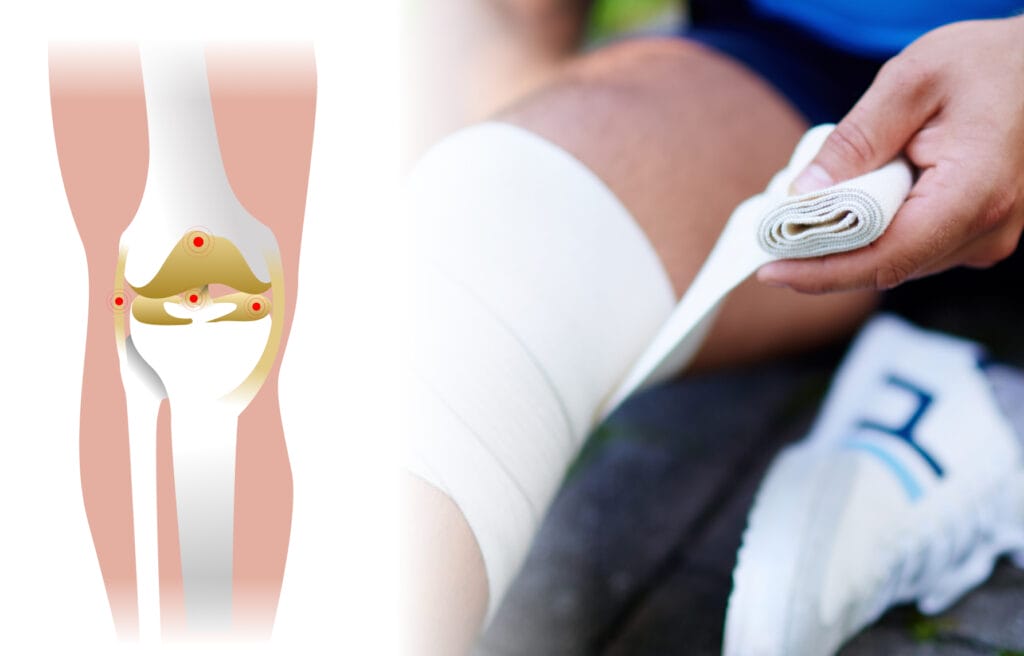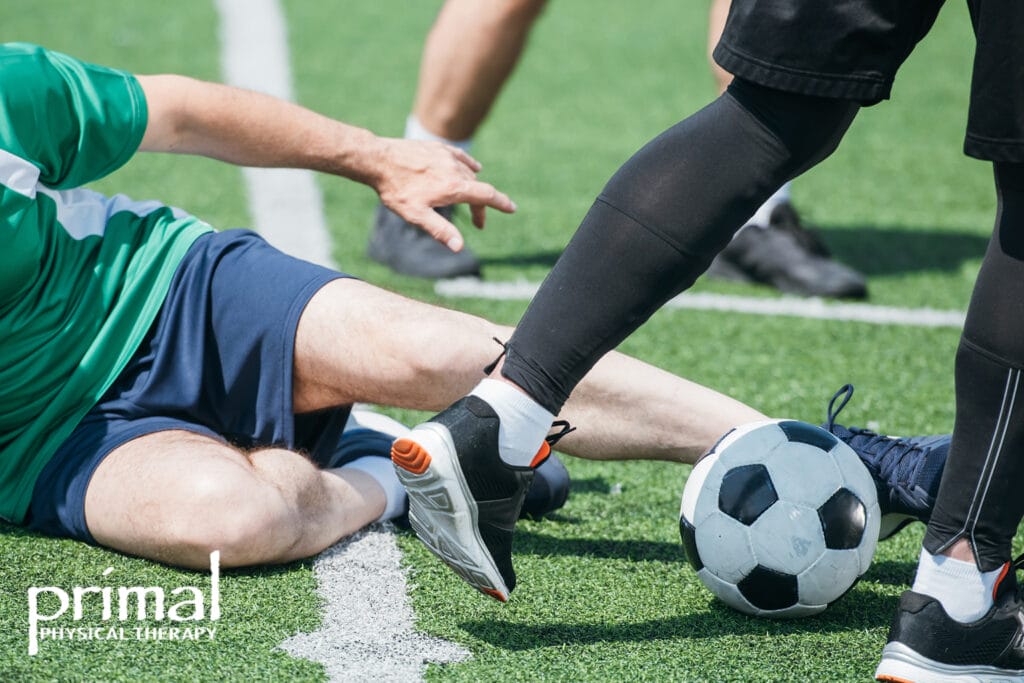As a physical therapist who has worked with countless athletes over the years, I can tell you that knee injuries in sports are among the most frequent concerns I see walking through my clinic doors. Whether you’re a weekend warrior or a professional athlete, understanding these injuries can help you recognize symptoms early and seek appropriate treatment.
Why Knee Injuries Are Common in Sports
The knee joint is one of the most complex parts of our body. Most people think it works like a hinge, but it has several components of twisting combined with bending to allow us so many degrees of motion. The knee joint has to carry all of your body weight. It also lets you move in several directions. When you do sports activities, your knee joint faces a lot of stress. This happens when you jump, make sudden stops, or change direction quickly.
The knee can be easily hurt because it needs ligaments and cartilage to stay stable. It’s not like the hip, which is a ball-and-socket joint. The knee depends a lot on strength, with emphasis on eccentric control to ensure control in all directions of movement. If these mechanics get damaged, common knee injuries can happen fast. When knee injuries occur, they can have a big effect on how well you do at sports.
The sports medicine field has found that there are several things that can make people more likely to hurt their knees. These things include having muscle imbalances, using poor body movement, not warming up properly, and having an old injury. It is important to know about these risk factors. This will help people stop injuries from happening and help them heal if they get hurt.

The 5 Most Common Knee Injuries in Sports
1. Anterior Cruciate Ligament (ACL) Tears
The anterior cruciate ligament is one of the most well-known ligament injuries in sports. This vital ligament goes across the middle of your knee. It helps prevent your shin bone from moving forward in relation to your thigh bone.
An ACL injury usually happens when you stop quickly, turn sharply, or land in a strange way after a jump. Many people report hearing a popping sound at the time of the injury. Right after that, there will often be severe pain and swelling. This kind of ACL injury is common in athletes.
The severity of the injury can range from small tears to full breaks. A complete ACL tear usually will not heal by itself because the ligament does not receive a sufficient blood supply. Most athletes who want to play sports that require a lot of cutting and turning will need surgery. After that, they must do about 6 to 9 months of physical therapy.
Recovery is about getting back your range of motion. You need to build up strength again and help your muscles work together like before. The good thing is that with the right ACL rehab, most athletes can go back to the same level of competition they had before.
2. Meniscus Tears
The meniscus is made up of two C-shaped pieces of cartilage. These pieces work like cushions between the thigh bone and shin bone. Meniscus tears are one of the most common types of sports injuries. This type of injury often happens in sports that have a lot of loading and twisting movements.
These injuries happen in two main ways. One is from a quick move, like twisting or turning fast. This is called an acute tear, and it often happens to young athletes. The other way is through wear and tear that builds up over the years. This type is called a degenerative tear and is more likely in athletes who are over 30.
Symptoms can be knee pain along the joint line. Swelling and stiffness are also common. Sometimes, you may feel a catching or locking feeling in your knee. The shape of the tear and the place where it occurs can change what treatment options you have. Some tears, like ones on the outer part of the meniscus where there is a good blood supply, might heal with simple, conservative treatment.
Physical therapy is very important when you are getting better from a meniscus injury. The main goal is to bring down swelling, help you move your knee again, and build up the surrounding muscles. These muscles help compensate for any shock absorption lost due to the injury.
3. Medial Collateral Ligament (MCL) Sprains
The medial collateral ligament is found on the inside of your knee. It links your thigh bone to your shin bone. A lot of ligament injuries in contact sports happen in this area. Most of the time, a hit on the outside of the knee causes it. Pushing the knee in can hurt the medial collateral ligament.
Unlike ACL injuries, MCL sprains often heal better because the MCL ligament receives good blood flow. Most of the time, MCL injuries can be treated well without surgery. Some complete tears can also get better this way.
The severity of the injury is rated from I to III. Grade I is a mild sprain. Grade III means there is a complete tear. The symptoms often include knee pain on the inside of the knee. There can also be swelling. Sometimes, it feels unstable when you move side to side. It is important to notice the severity of the injury and find help if you feel any pain or see swelling in your knee.
Treatment usually starts with a short period where you need to protect the injured area. After that, you will start physical therapy. This helps you build back your strength, helps with flexibility, and gets you moving in the right way again. Most athletes are able to get back to sports anywhere from 2 to 8 weeks. It depends on how bad the injury is.
4. Lateral Collateral Ligament (LCL) Injuries
The lateral collateral ligament helps keep the outside part of your knee joint steady. Injuries to the LCL do not happen as often as injuries to the MCL. However, the LCL can be more challenging to repair due to its location within the knee joint and the surrounding areas.
These injuries usually happen when the knee gets pushed inward while the foot stays on the ground. They can also come from the knee being stretched back too far. Many athletes report feeling knee pain on the outside of their knee. They may also feel like the knee is not steady, especially when they cut or turn quickly.
LCL injuries often happen when there are other ligament tears too, like tears of the posterior cruciate ligament or the posterolateral corner of the knee. This can make things more complicated. Because of this, it can be harder to find out what is wrong and to choose the right treatment. You may need special scans and a sports medicine doctor to look at the injury closely.
Recovery time can change a lot. It depends on the severity of the injury and the extent of any other damage. Physical therapy is used to help with strength differences. It also works to build body awareness. Over time, you will gradually return to your sport. The focus will be on the severity of the injury and what you need to do to feel better.
5. Patellofemoral Pain Syndrome (Runner’s Knee)
Patellofemoral pain syndrome is often called “runner’s knee.” It is a main cause of knee pain that people feel around or behind the kneecap. This is not just one injury. It happens when several problems affect the front of the knee, where the patella (kneecap) meets the femur.
This problem usually happens slowly over time, not from just one big injury. The way the body moves, weak hip and glute muscles, and mistakes in training are some of the main reasons for it.
Athletes often experience knee pain, which worsens when they run, jump, squat, or go up stairs. The knee pain can also come with a grinding or clicking feeling when the knee is bent.
The nice thing about patellofemoral pain syndrome is that it often gets better with simple care. Most people feel a lot better with physical therapy. This kind of therapy works on hip strength, core stability, and the way you move. Sticking to the rehabilitation program can fix the symptoms for most people. It can take about 6 to 12 weeks to feel good again, but if you keep at it, you should see results.
Related Article: Most Common Shoulder Injuries in Sports

Sports With the Greatest Risk for Knee Injuries
Understanding which sports carry the highest risk for these common knee injuries can help athletes and coaches implement targeted prevention strategies.
- Basketball and soccer top the list for ACL injury rates, particularly among female athletes. The combination of jumping, landing, cutting, and pivoting creates the perfect storm for ACL tears. Football also sees significant ACL injury rates, though the mechanism is often different, involving contact situations.
- American football leads in MCL injuries due to the high-contact nature and frequency of lateral blows to the knee. Hockey and rugby also see elevated rates of MCL sprains for similar reasons.
- Meniscus tears are common across many sports but are particularly prevalent in basketball, football, soccer, and tennis—sports that involve frequent direction changes and pivoting movements.
- Running sports naturally see higher rates of patellofemoral pain syndrome, including track and field, cross country, and recreational running. However, any sport involving repetitive knee flexion can contribute to this condition.
- LCL injuries are less sport-specific but occur more frequently in activities with high forces and complex movement patterns, such as skiing, football, and martial arts.
Your Next Steps in Knee Injury Prevention
The main point here is that to stop sports injuries, you need to fit the plan to your sport. Each sport has its own needs and movements, so your safety steps should match those. It is a good idea to work with people who know about sports medicine. When you use sports injury prevention programs, you can lower your chances of having knee injuries.
It is essential to be proactive about injury prevention. Knowing where our weaknesses are and building on our strengths to enhance our performance in sport can also be how we prevent injuries from occurring in the first place. This can help you feel better sooner and return to your sport faster. If you have knee pain that does not go away or if you worry you might have hurt it, talk with a healthcare expert soon. Our physical therapy in Bryn Mawr can help you identify the issue and provide guidance on what to do next.
For the best physical therapy for your sports-related knee injury, contact us today!